Room-Temperature (RT) Extended Short-Wave Infrared (e-SWIR) Avalanche Photodiode (APD) with a 2.6 µm Cutoff Wavelength
Abstract
:1. Introduction
2. Device Structures, Material Growth, and the Device Fabrication
3. Results and Discussions
4. Conclusions
Author Contributions
Funding
Data Availability Statement
Acknowledgments
Conflicts of Interest
References
- Liu, L.; Rabinowitz, J.; Bianconi, S.; Park, M.-S.; Mohseni, H. Highly sensitive SWIR detector array based on nanoscale phototransistors integrated on CMOS readout. Appl. Phys. Lett. 2020, 117, 191102. [Google Scholar] [CrossRef]
- Wen, M.; Wei, L.; Zhuang, X.; He, D.; Wang, S.; Wang, Y. High-sensitivity short-wave infrared technology for thermal imaging. Infrared Phys. Technol. 2018, 95, 93–99. [Google Scholar] [CrossRef]
- Hinds, S.; Klem, E.; Gregory, C.; Hilton, A.; Hames, G.; Violette, K. Extended SWIR High Performance and High Definition Colloidal Quantum Dot Imagers; SPIE: Bellingham, WA, USA, 2020; Volume 11407. [Google Scholar]
- Treps, N. Surpassing the Standard Quantum Limit for Optical Imaging Using Nonclassical Multimode Light. Phys. Rev. Lett. 2002, 88, 203601. [Google Scholar] [CrossRef] [PubMed]
- Pooser, R.C.; Lawrie, B. Plasmonic Trace Sensing below the Photon Shot Noise Limit. ACS Photonics 2016, 3, 8–13. [Google Scholar] [CrossRef]
- Lee, C.; Lawrie, B.; Pooser, R.; Lee, K.-G.; Rockstuhl, C.; Tame, M. Quantum Plasmonic Sensors. Chem. Rev. 2021, 121, 4743–4804. [Google Scholar] [CrossRef] [PubMed]
- Arslan, Y.; Oguz, F.; Besikci, C. Extended wavelength SWIR InGaAs focal plane array: Characteristics and limitations. Infrared Phys. Technol. 2015, 70, 134–137. [Google Scholar] [CrossRef]
- Martinelli, R.U.; Zamerowski, T.J.; Longeway, P.A. 2.6 μm InGaAs photodiodes. Appl. Phys. Lett. 1988, 53, 989–991. [Google Scholar] [CrossRef]
- Linga, K.R.; Olsen, G.H.; Ban, V.S.; Joshi, A.N.; Kosonocky, W.F. Dark current analysis and characterization of In/sub x/Ga/sub 1-x/As/InAs/sub y/P/sub 1-y/ graded photodiodes with x>0.53 for response to longer wavelengths (>1.7 mu m). J. Light. Technol. 1992, 10, 1050–1055. [Google Scholar] [CrossRef]
- Olsen, G.; Lange, M.; Cohen, M.; Kim, D.-S.; Forrest, S. Three-Band 1.0–2.5 um Near-Infrared InGaAs Detector Array; SPIE: Bellingham, WA, USA, 1994; Volume 2225. [Google Scholar]
- Zimmermann, L.; John, J.; Degroote, S.; Borghs, G.; Hoof, C.V.; Nemeth, S. Extended wavelength InGaAs on GaAs using InAlAs buffer for back-side-illuminated short-wave infrared detectors. Appl. Phys. Lett. 2003, 82, 2838–2840. [Google Scholar] [CrossRef]
- Ting, D.Z.-Y.; Hill, C.J.; Soibel, A.; Keo, S.A.; Mumolo, J.M.; Nguyen, J.; Gunapala, S.D. A high-performance long wavelength superlattice complementary barrier infrared detector. Appl. Phys. Lett. 2009, 95, 023508. [Google Scholar] [CrossRef]
- Youngdale, E.R.; Meyer, J.R.; Hoffman, C.A.; Bartoli, F.J.; Grein, C.H.; Young, P.M.; Ehrenreich, H.; Miles, R.H.; Chow, D.H. Auger lifetime enhancement in InAs–Ga1−xInxSb superlattices. Appl. Phys. Lett. 1994, 64, 3160–3162. [Google Scholar] [CrossRef]
- Delaunay, P.Y.; Nguyen, B.M.; Hoffman, D.; Huang, E.K.W.; Razeghi, M. Background Limited Performance of Long Wavelength Infrared Focal Plane Arrays Fabricated From M-Structure InAs–GaSb Superlattices. IEEE J. Quantum Electron 2009, 45, 157–162. [Google Scholar] [CrossRef]
- Nguyen, B.-M.; Hoffman, D.; Delaunay, P.-Y.; Razeghi, M. Dark current suppression in type II InAs∕GaSb superlattice long wavelength infrared photodiodes with M-structure barrier. Appl. Phys. Lett. 2007, 91, 163511. [Google Scholar] [CrossRef]
- Cohen-Elias, D.; Uliel, Y.; Klin, O.; Snapi, N.; Weiss, E.; Shafir, I.; Westreich, O.; Katz, M. Short wavelength infrared InAs/InSb/AlSb type-II superlattice photodetector. Infrared Phys. Technol. 2017, 84, 82–86. [Google Scholar] [CrossRef]
- Jones, A.H.; March, S.D.; Bank, S.R.; Campbell, J.C. Low-noise high-temperature AlInAsSb/GaSb avalanche photodiodes for 2-μm applications. Nat. Photonics 2020, 14, 559–563. [Google Scholar] [CrossRef]
- Savich, G.R.; Sidor, D.E.; Du, X.; Wicks, G.W.; Debnath, M.C.; Mishima, T.D.; Santos, M.B.; Golding, T.D.; Jain, M.; Craig, A.P.; et al. III–V semiconductor extended short-wave infrared detectors. J. Vac. Sci. Technol. B 2017, 35, 02B105. [Google Scholar] [CrossRef]
- Wicks, G.; Golding, T.; Jain, M.; Savich, G.; Sidor, D.; Du, X.; Debnath, M.; Mishima, T.; Santos, M. Extended-Shortwave Infrared Unipolar Barrier Detectors; SPIE: Bellingham, WA, USA, 2015; Volume 9370. [Google Scholar]
- Leemans, J.; Pejović, V.; Georgitzikis, E.; Minjauw, M.; Siddik, A.B.; Deng, Y.-H.; Kuang, Y.; Roelkens, G.; Detavernier, C.; Lieberman, I.; et al. Colloidal III–V Quantum Dot Photodiodes for Short-Wave Infrared Photodetection. Adv. Sci. 2022, 9, 2200844. [Google Scholar] [CrossRef]
- Miao, Y.; Lin, H.; Li, B.; Dong, T.; He, C.; Du, J.; Zhao, X.; Zhou, Z.; Su, J.; Wang, H.; et al. Review of Ge(GeSn) and InGaAs Avalanche Diodes Operating in the SWIR Spectral Region. Nanomaterials 2023, 13, 606. [Google Scholar] [CrossRef]
- Tran, H.; Pham, T.; Du, W.; Zhang, Y.; Grant, P.C.; Grant, J.M.; Sun, G.; Soref, R.A.; Margetis, J.; Tolle, J.; et al. High performance Ge0.89Sn0.11 photodiodes for low-cost shortwave infrared imaging. J. Appl. Phys. 2018, 124, 013101. [Google Scholar] [CrossRef]
- Eales, T.D.; Marko, I.P.; Schulz, S.; O’Halloran, E.; Ghetmiri, S.; Du, W.; Zhou, Y.; Yu, S.-Q.; Margetis, J.; Tolle, J.; et al. Ge1−xSnx alloys: Consequences of band mixing effects for the evolution of the band gap Γ-character with Sn concentration. Sci. Rep. 2019, 9, 14077. [Google Scholar] [CrossRef]
- Dong, Y.; Wang, W.; Lee, S.Y.; Lei, D.; Gong, X.; Loke, W.K.; Yoon, S.F.; Liang, G.; Yeo, Y.C. Avalanche photodiode featuring Germanium-tin multiple quantum wells on silicon: Extending photodetection to wavelengths of 2 and beyond. In Proceedings of the 2015 IEEE International Electron Devices Meeting (IEDM), Washington, DC, USA, 7–9 December 2015; pp. 30.35.31–30.35.34. [Google Scholar]
- Yang, J.; Hu, H.; Miao, Y.; Wang, B.; Wang, W.; Su, H.; Ma, Y. Single-crystalline GePb alloys formed by rapid thermal annealing-induced epitaxy. J. Phys. D Appl. Phys. 2020, 53, 265105. [Google Scholar] [CrossRef]
- Besikci, C. Extended Short Wavelength infrared FPA Technology: Status and Trends; SPIE: Bellingham, WA, USA, 2018; Volume 10540. [Google Scholar]
- Olsen, G.; Joshi, A.; Mason, S.; Woodruff, K.; Mykietyn, E.; Ban, V.; Lange, M.; Hladky, J.; Erickson, G.; Gasparian, G. Room-Temperature InGaAs Detector Arrays for 2.5 µm; SPIE: Bellingham, WA, USA, 1990; Volume 1157. [Google Scholar]
- D’Souza, A.; Stapelbroek, M.; Dawson, L.; Ely, P.; Yoneyama, C.; Reekstin, J.; Skokan, M.; Kinch, M.; Liao, P.; Ohlson, M.; et al. SWIR to LWIR HDVIP HgCdTe Detector Array Performance; SPIE: Bellingham, WA, USA, 2006; Volume 6206. [Google Scholar]
- Wang, H.; Xia, H.; Liu, Y.; Chen, Y.; Xie, R.; Wang, Z.; Wang, P.; Miao, J.; Wang, F.; Li, T.; et al. Room-temperature low-threshold avalanche effect in stepwise van-der-Waals homojunction photodiodes. Nat. Commun. 2024, 15, 3639. [Google Scholar] [CrossRef] [PubMed]
- Dupuis, R.D.; Velebir, J.R.; Campbell, J.C.; Qua, G.J. Avalanche photodiodes with separate absorption and multiplication regions grown by metalorganic vapor deposition. IEEE Electron Device Lett. 1986, 7, 296–298. [Google Scholar] [CrossRef]
- Li, J.; Dehzangi, A.; Brown, G.; Razeghi, M. Mid-wavelength infrared avalanche photodetector with AlAsSb/GaSb superlattice. Sci. Rep. 2021, 11, 7104. [Google Scholar] [CrossRef] [PubMed]
- Moss, T.S. The Interpretation of the Properties of Indium Antimonide. Proc. Phys. Society Sect. B 1954, 67, 775–782. [Google Scholar] [CrossRef]
- Burstein, E. Anomalous Optical Absorption Limit in InSb. Phys. Rev. 1954, 93, 632–633. [Google Scholar] [CrossRef]
- Ghezzi, C.; Magnanini, R.; Parisini, A.; Rotelli, B.; Tarricone, L.; Bosacchi, A.; Franchi, S. Concentration dependence of optical absorption in tellurium-doped GaSb. Semicond. Sci. Technol. 1997, 12, 858–866. [Google Scholar] [CrossRef]
- Xiang, B.; Gu, G.; Ramaswamyd, N.; Drew, C.; Lu, X. Voltage-dependent extended shortwave infrared (e-SWIR) photodetection-band tuning utilizing the Moss–Burstein effect. J. Phys. D Appl. Phys. 2023, 56, 055101. [Google Scholar] [CrossRef]
- McIntyre, R.J. Multiplication noise in uniform avalanche diodes. IEEE Trans. Electron Devices 1966, ED-13, 164–168. [Google Scholar] [CrossRef]
- Sze, S.M.; Ng, K.K. Physics of Semiconductor Devices; Wiley: Hoboken, NJ, USA, 2006. [Google Scholar]

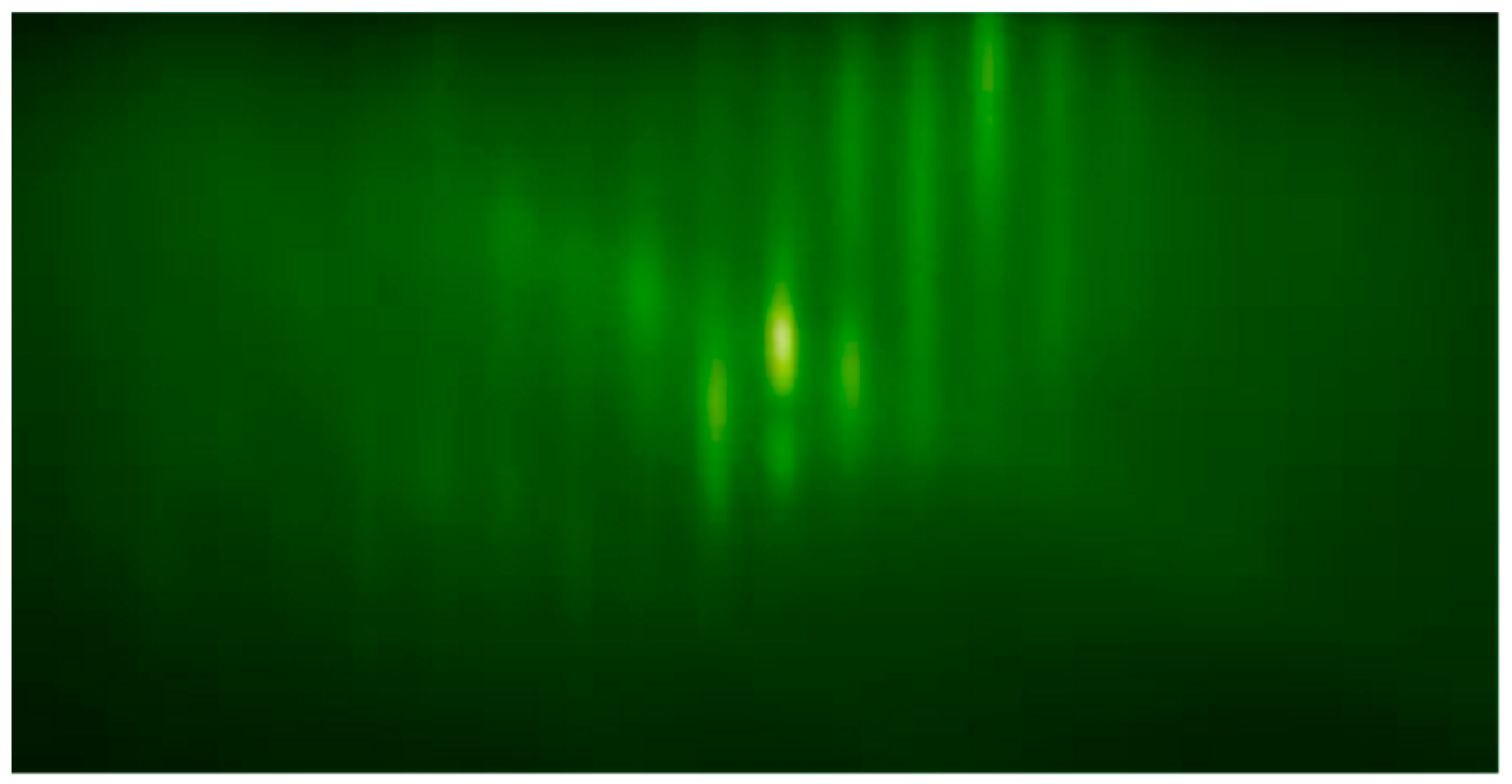
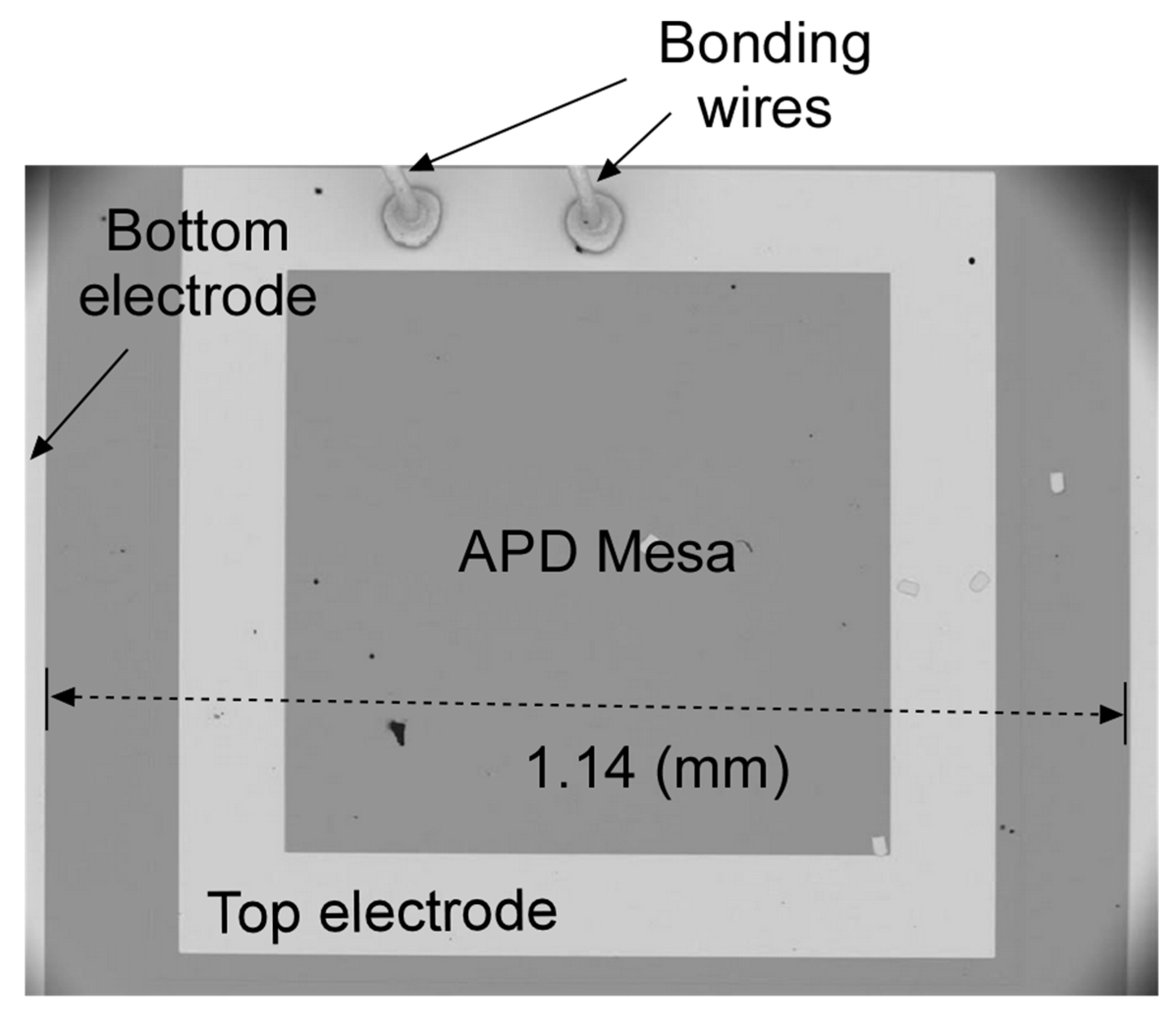
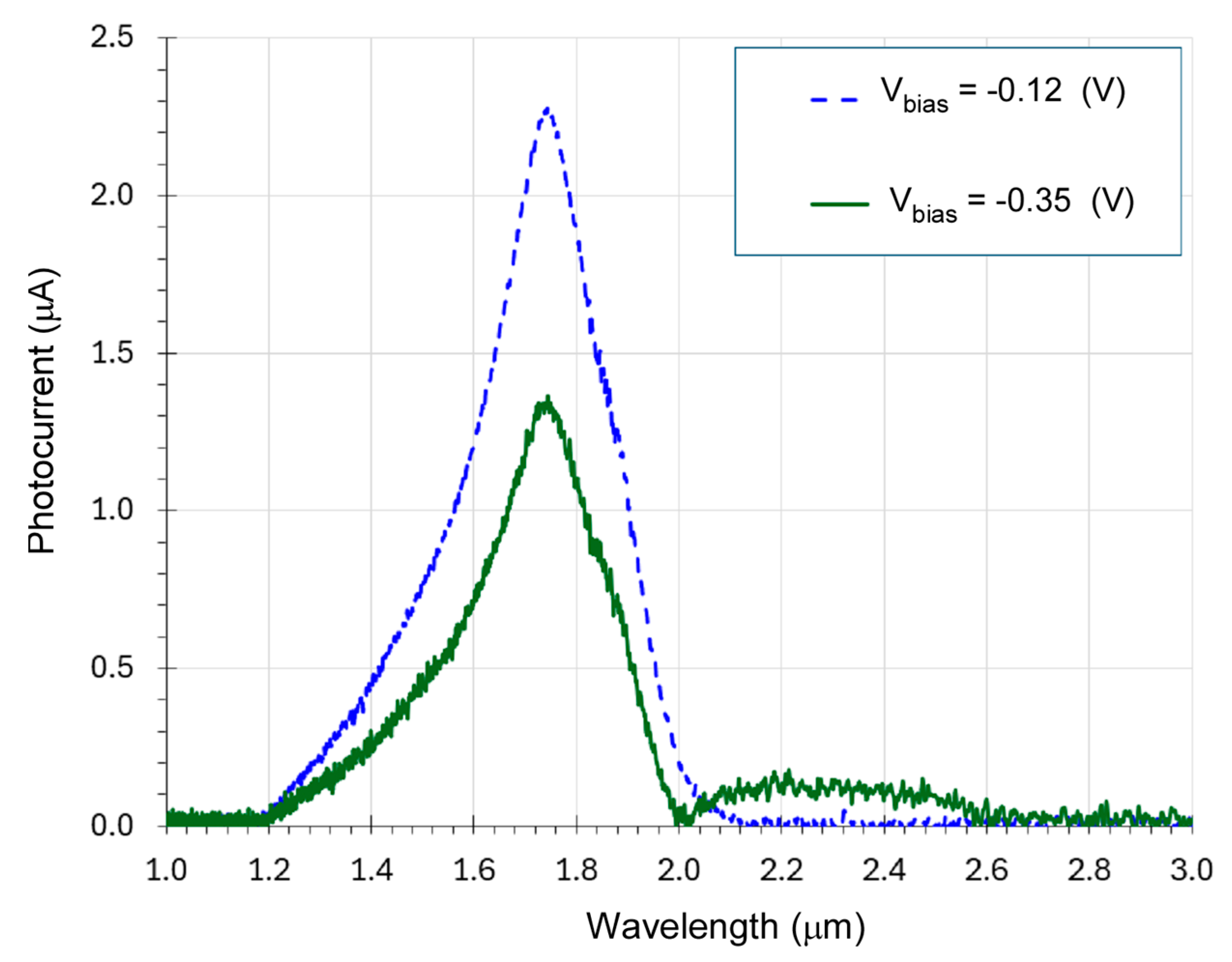
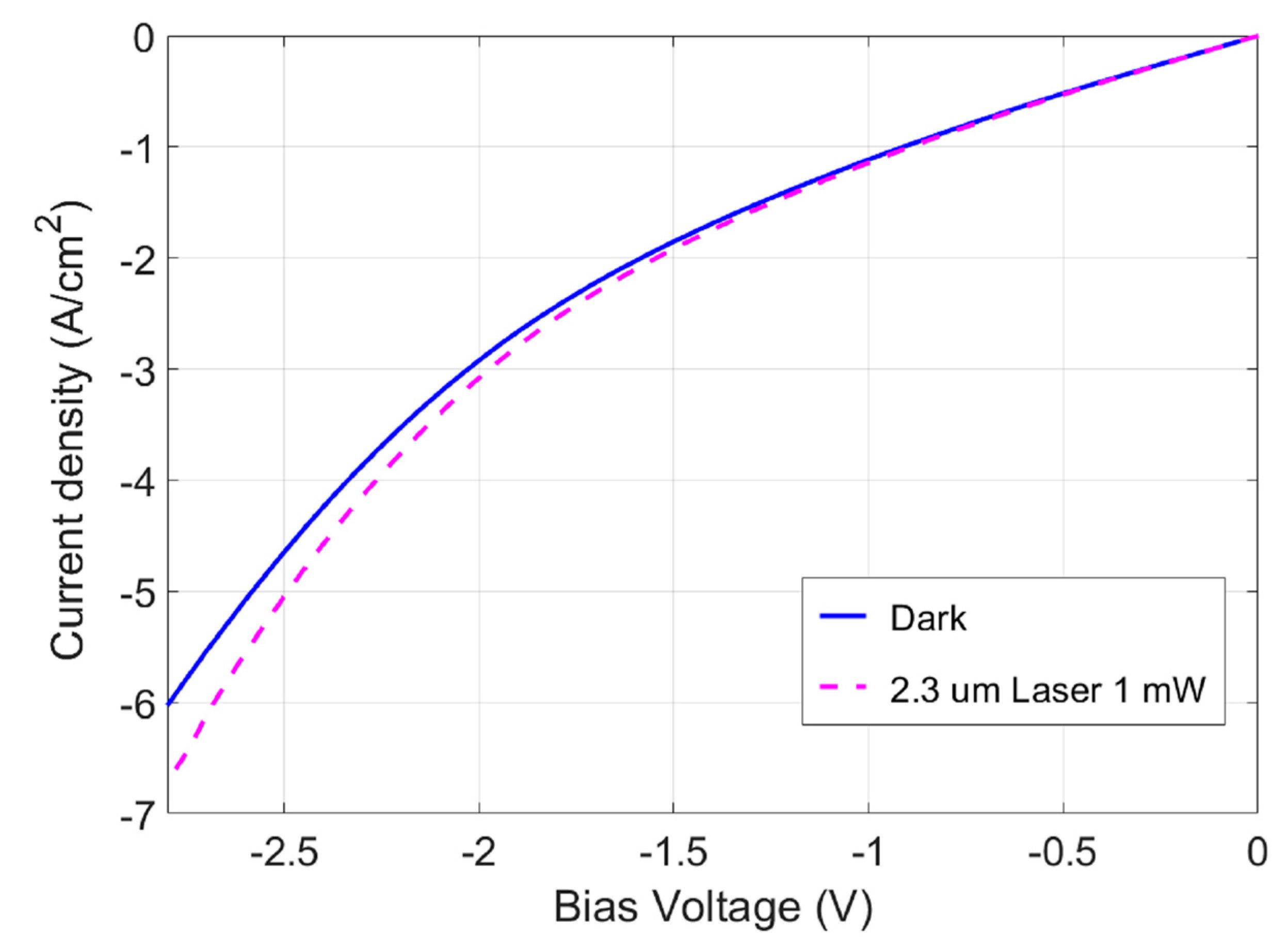
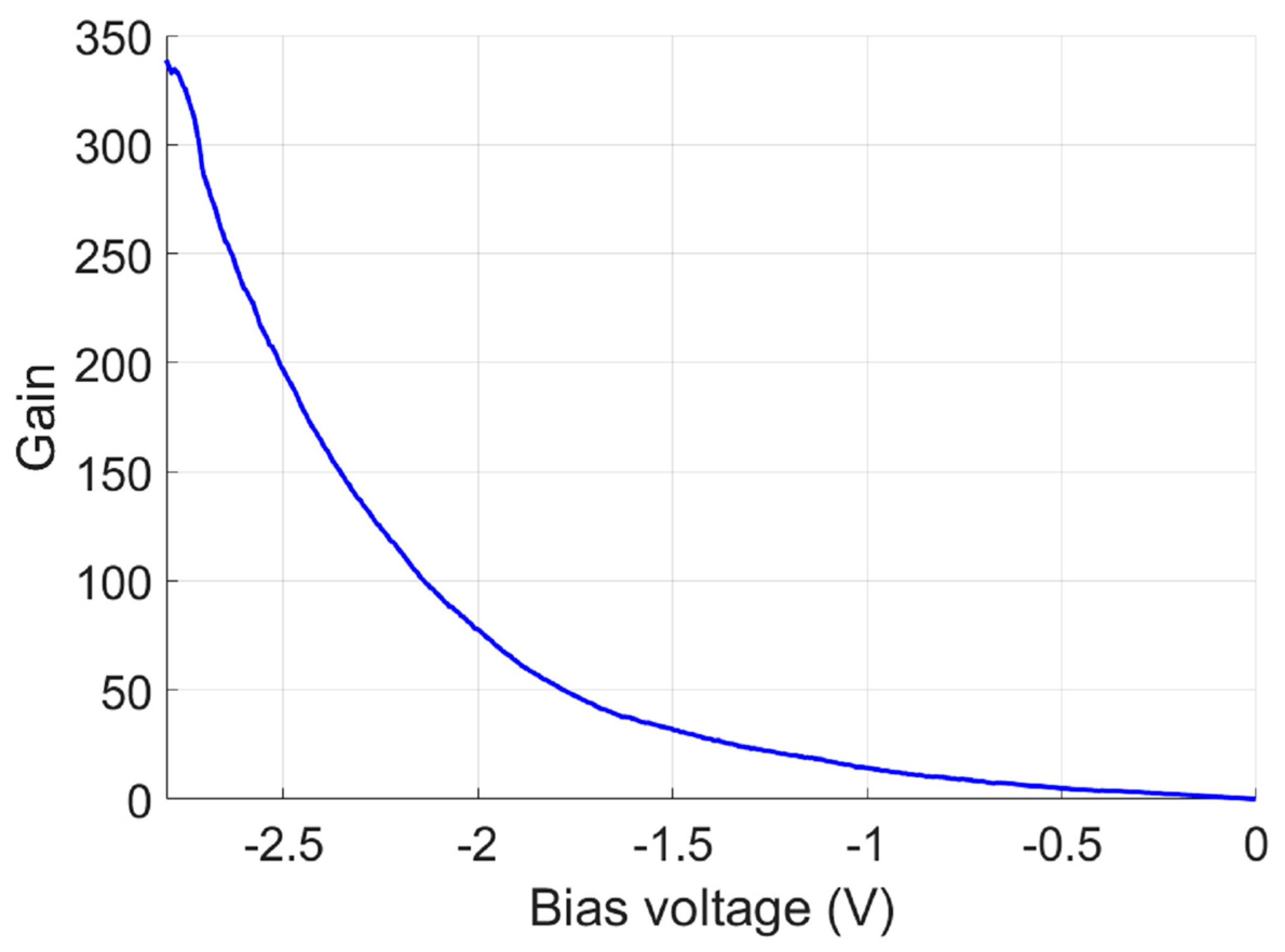
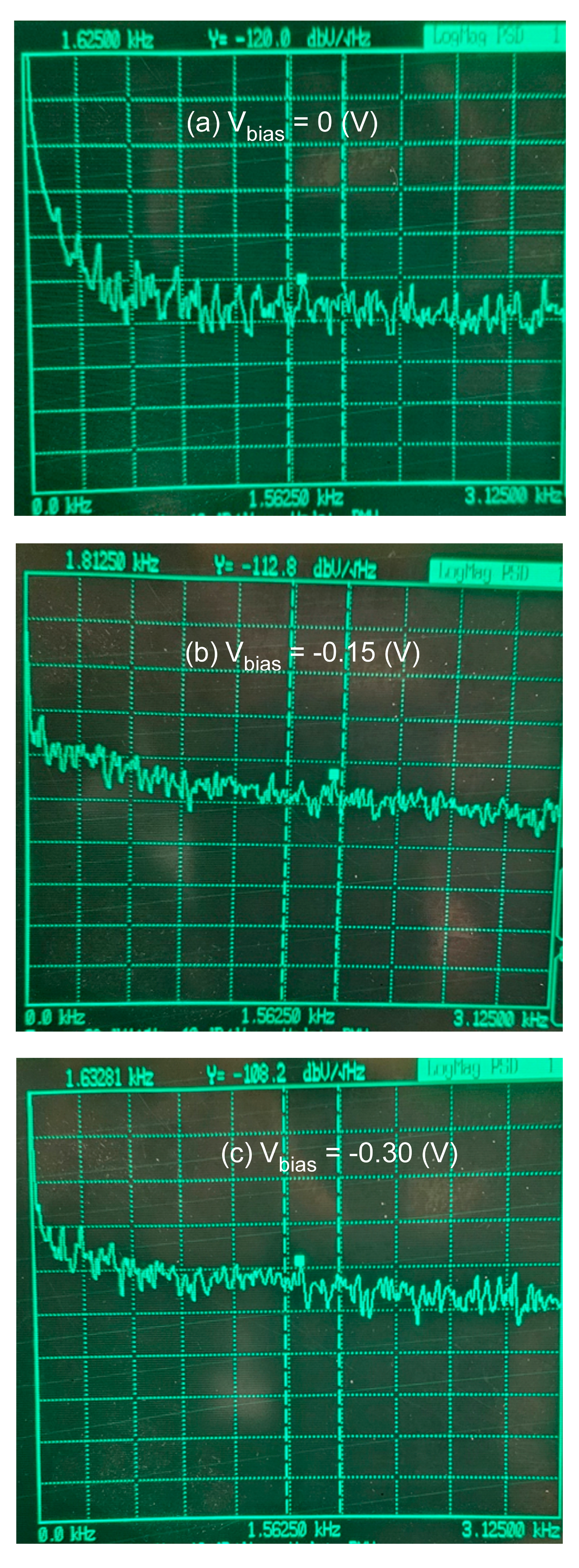
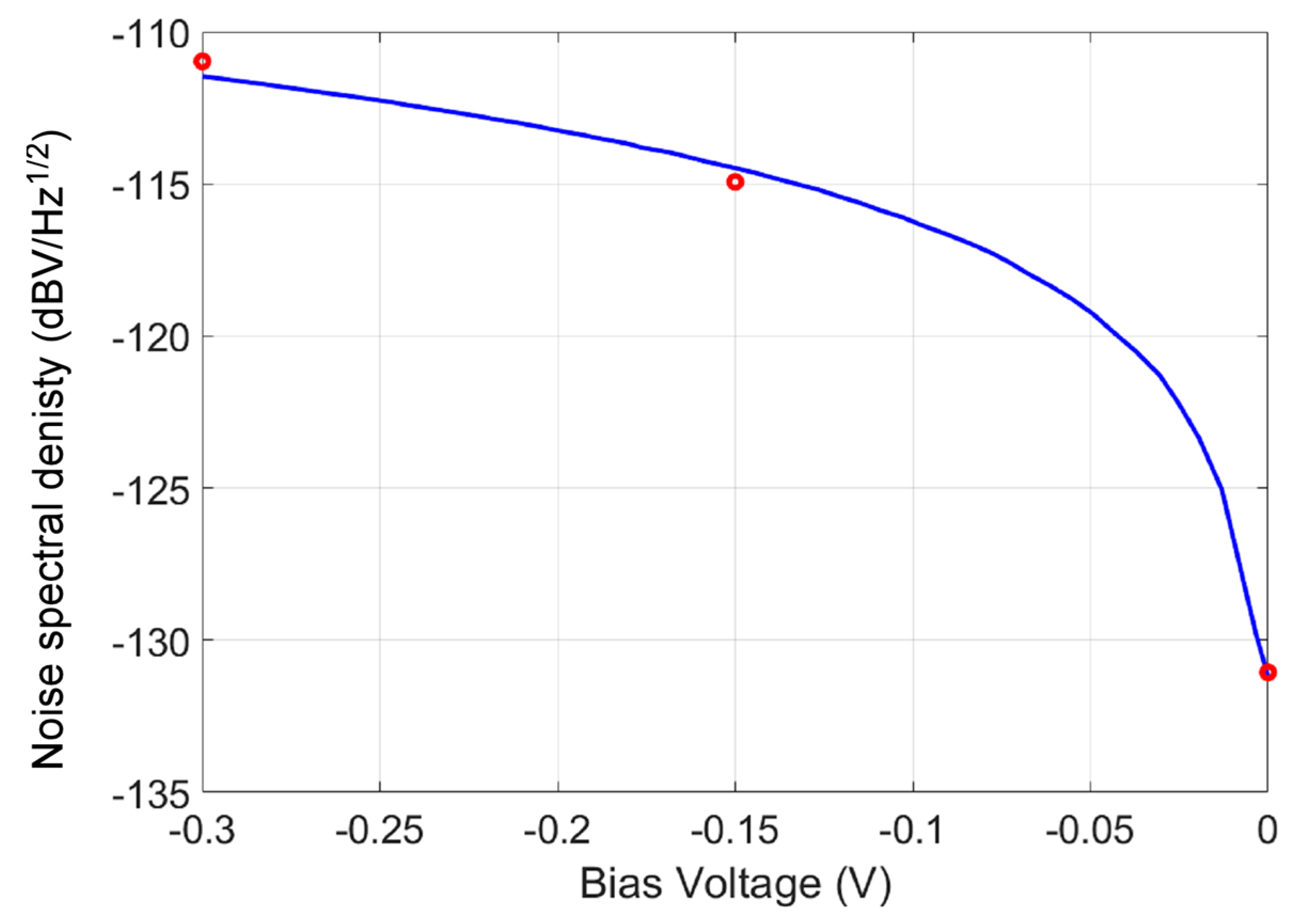
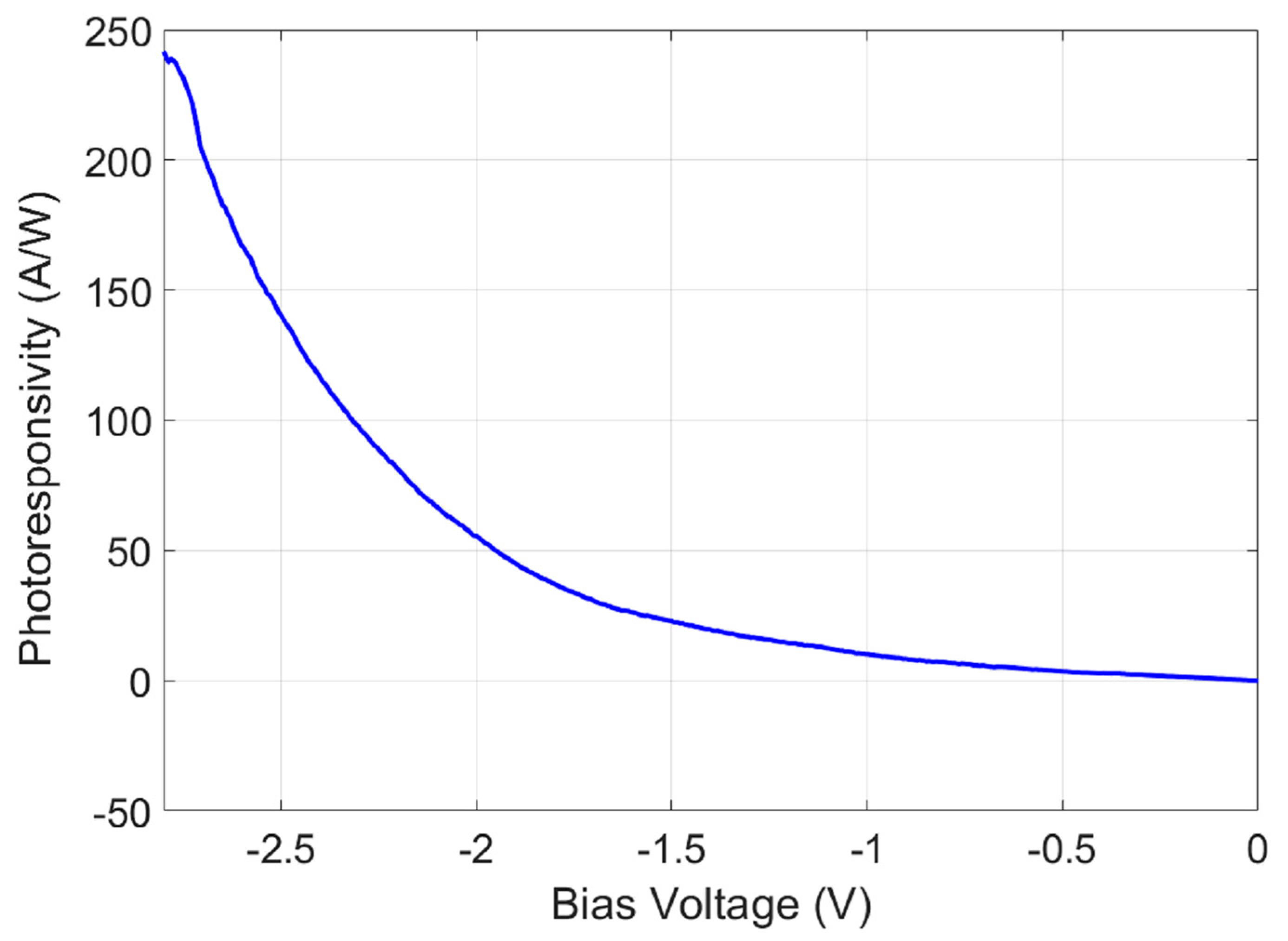

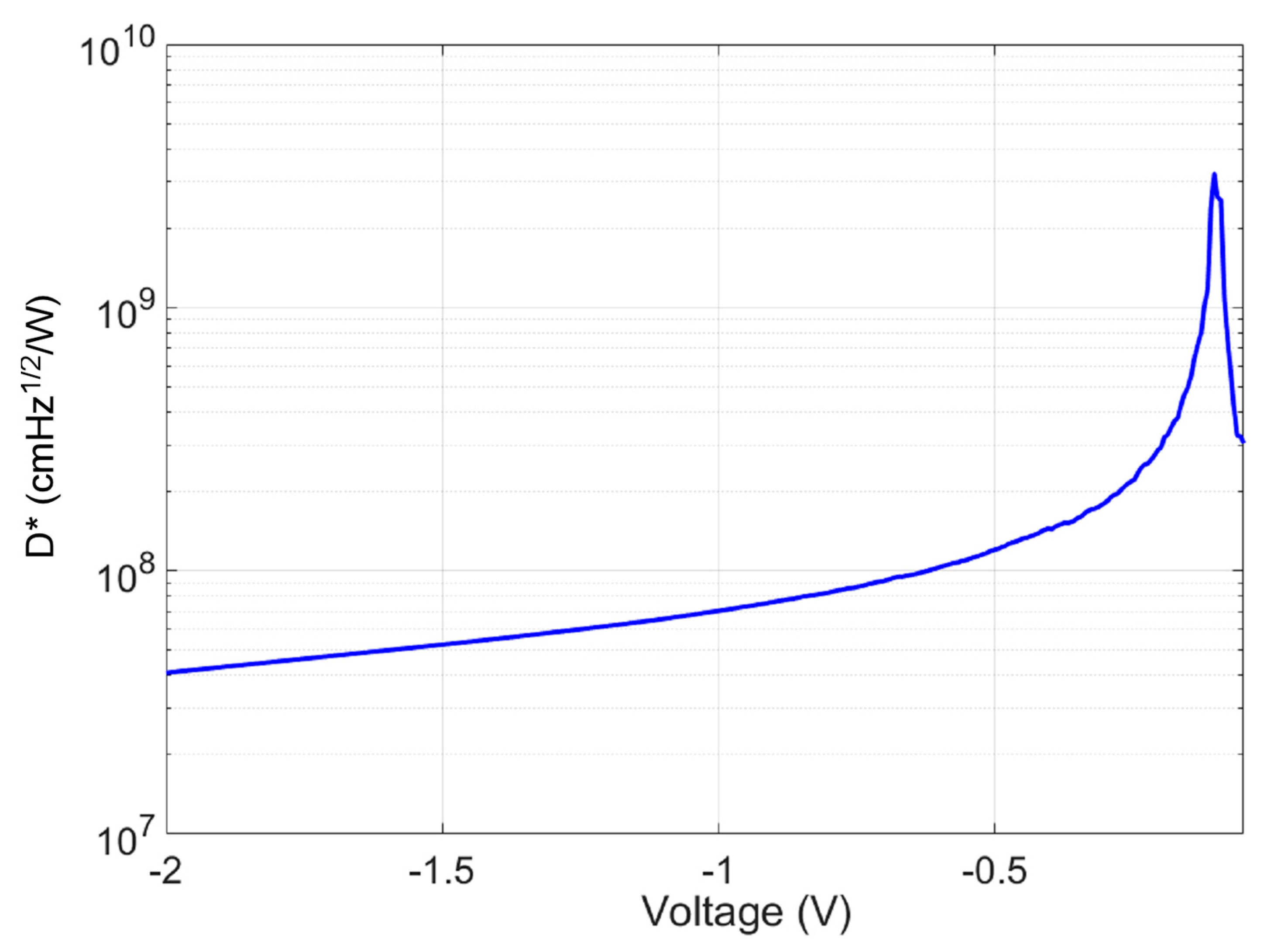
| Performance Features | This Work | AlInAsSb/GaSb APD [17] | Ge1−xSnx APD [24] | Stepwise WSe2 APD [29] |
|---|---|---|---|---|
| Cutoff Wavelength (µm) | 2.6 | 2.0 | 2.003 | <1 |
| Gain | 190 | >100 | >15 | >100 |
| Operating Temperature | RT | RT | RT | RT |
| Reverse Bias (V) | <2.5 | >20 | <10 | <1.6 |
| K-Factor | N/A | N/A | ||
| Photoresponsivity (A/W) | N/A | 0.33 | N/A | |
| N/A | N/A | N/A |
Disclaimer/Publisher’s Note: The statements, opinions and data contained in all publications are solely those of the individual author(s) and contributor(s) and not of MDPI and/or the editor(s). MDPI and/or the editor(s) disclaim responsibility for any injury to people or property resulting from any ideas, methods, instructions or products referred to in the content. |
© 2024 by the authors. Licensee MDPI, Basel, Switzerland. This article is an open access article distributed under the terms and conditions of the Creative Commons Attribution (CC BY) license (https://creativecommons.org/licenses/by/4.0/).
Share and Cite
Benker, M.; Gu, G.; Senckowski, A.Z.; Xiang, B.; Dwyer, C.H.; Adams, R.J.; Xie, Y.; Nagarajan, R.; Li, Y.; Lu, X. Room-Temperature (RT) Extended Short-Wave Infrared (e-SWIR) Avalanche Photodiode (APD) with a 2.6 µm Cutoff Wavelength. Micromachines 2024, 15, 941. https://doi.org/10.3390/mi15080941
Benker M, Gu G, Senckowski AZ, Xiang B, Dwyer CH, Adams RJ, Xie Y, Nagarajan R, Li Y, Lu X. Room-Temperature (RT) Extended Short-Wave Infrared (e-SWIR) Avalanche Photodiode (APD) with a 2.6 µm Cutoff Wavelength. Micromachines. 2024; 15(8):941. https://doi.org/10.3390/mi15080941
Chicago/Turabian StyleBenker, Michael, Guiru Gu, Alexander Z. Senckowski, Boyang Xiang, Charles H. Dwyer, Robert J. Adams, Yuanchang Xie, Ramaswamy Nagarajan, Yifei Li, and Xuejun Lu. 2024. "Room-Temperature (RT) Extended Short-Wave Infrared (e-SWIR) Avalanche Photodiode (APD) with a 2.6 µm Cutoff Wavelength" Micromachines 15, no. 8: 941. https://doi.org/10.3390/mi15080941







